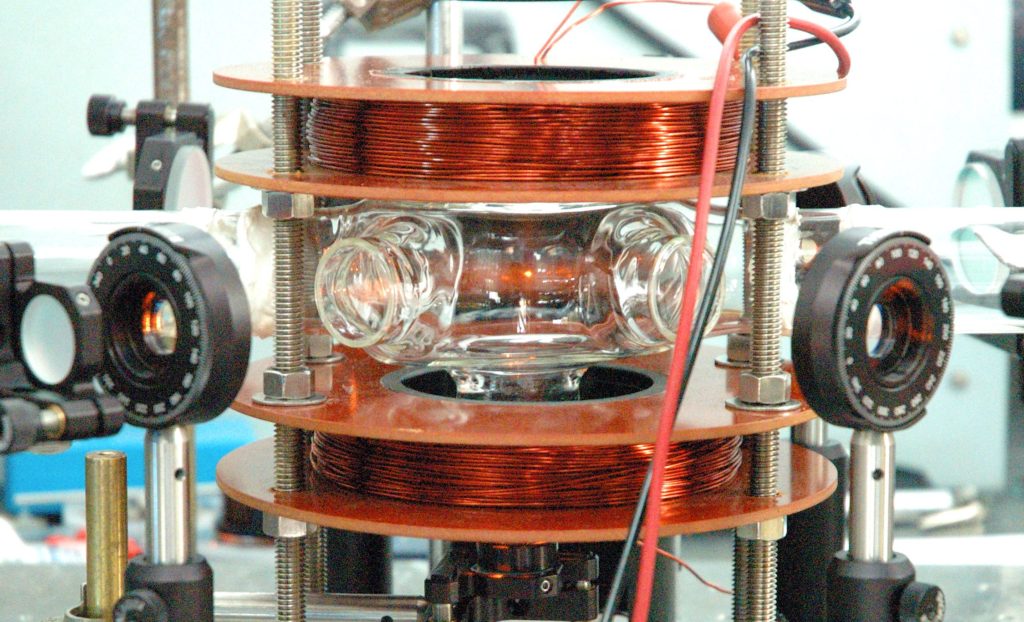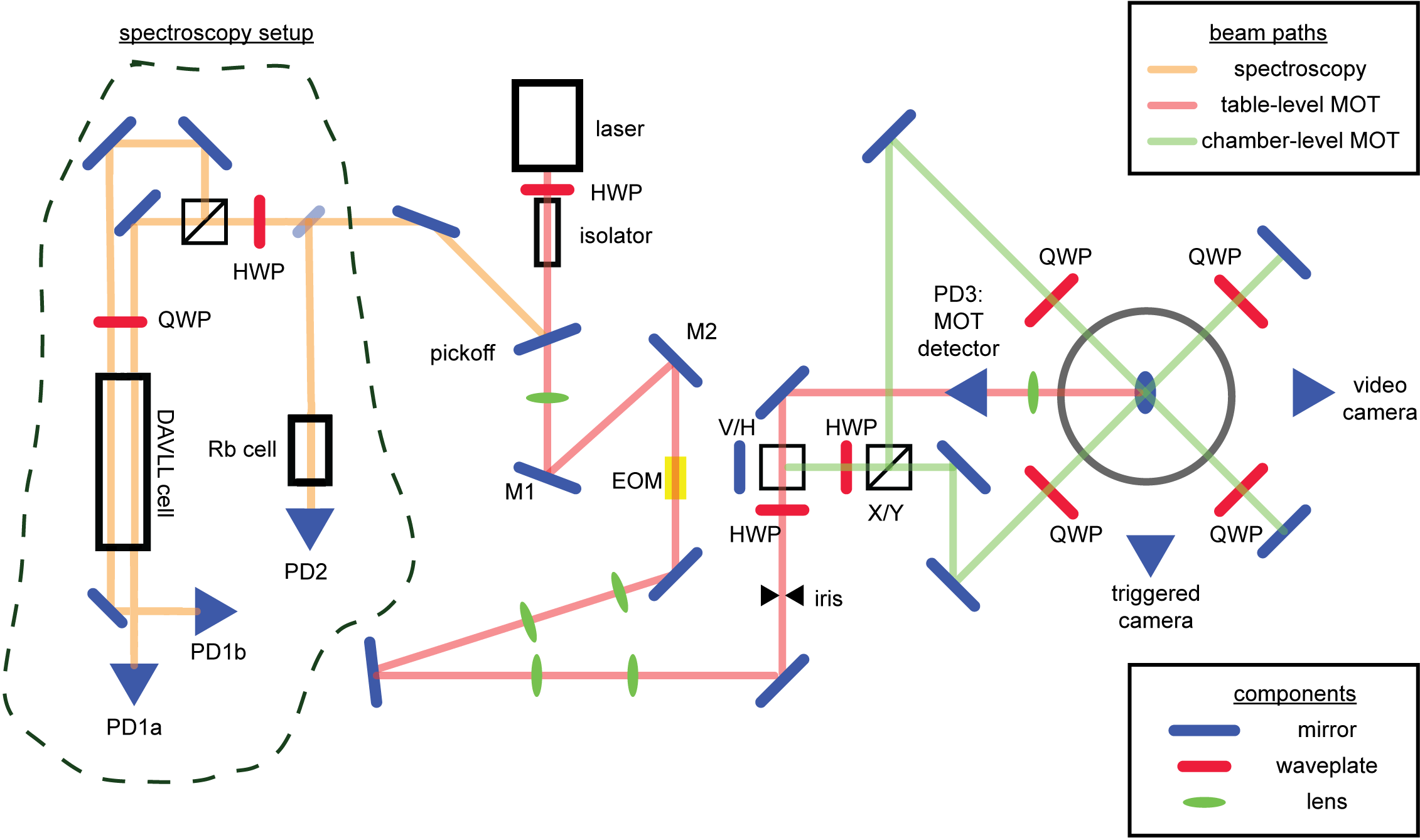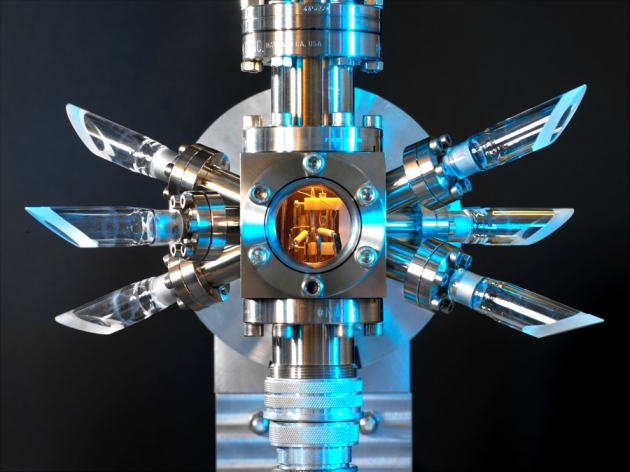In this blog post we will learn about magneto-optical traps. An important scientific technique that has found quite a few important applications at the forefronts of science and technology. In this post we will give a brief intro to magneto-optical traps, will cover the principles of operation and look into three important applications:
- What are Magneto-Optical Traps (MOTs)
- Principles of Operations of MOTs
- 3 Applications of Magneto-Optical Traps

Magneto-Optical Traps (MOTs) utilize lasers and magnets to trap atoms. Courtesy of BCIT
What are Magneto-Optical Traps?
At room temperature, most atoms travel at thousands of meters per second. The random and rapid movement of atoms make them difficult to study. Experimentation with cold atoms is therefore highly desirable because the atoms attain longer interaction and observation times, allowing for easier examination. Magneto-Optical Traps (MOTs) utilize techniques of laser-cooling with the influence of strong magnetic coils to collect samples of cooled and “trapped” atoms. We could use these samples in experiments concerning quantum phenomena. In fact, due to their frequent success and relative simplicity, MOTs are the modern standard for atom cooling.
Principles of Operation of MOTs
MOTs significantly reduce the speed of neutral atoms – therefore cooling them – and then bringing these cooled atoms to a centralized location where they can be prepped for experimentation. A typical MOT setup is built around an ultra-high vacuum chamber into which the neutral atom sample is contained. The magnetic coils are on opposing sides of the chamber, thus creating a centralized magnetic field through the the sample. In addition, laser light is reflected through the chamber and subjects the sample to absorb photons from the incident light. These absorptions cause the atoms to slowly lose momentum, as they spontaneously emit photons in all directions. The magnetic field then centralizes these cooled atoms. The result is a created cold atom cloud.

An example of the complex optical path a laser takes before entering the MOT (pictured as a circle on the far right). Courtesy of University of California, Berkeley
Traditional magneto-optical trap setups use semi-conductor lasers as the light source in collaboration with anti-Helmholtz magnetic coils. Experiments involving magneto-optical traps also include a complex optical setup to assure that the laser light of precise wavelength and power enters into the vacuum chamber along all three dimensions to create proper cooling.
3 Applications of Magneto-Optical Traps
MOT methods can be applied to a wide array of cold-atom experimentation. As noted previously, magneto-optical traps are the most common tool in cooling atoms. Specifically, experiments involving cold atoms can reveal precise information about atomic behavior. Furthermore, the application of cold atom experimentation to products of industry could produce some of the largest technological advancements in centuries.
1. Bose-Einstein Condensation
Among the five states of matter, gases, liquids, solids, and plasmas are well studied and defined. The Bose-Einstein condensate (BEC), however, was not created in a lab until 1995, making it the least understood state in modern science. BEC is a group of atoms cooled down to near absolute zero, at which point the atoms enter the same energy state and the system begins to behave as one single atom. This state of matter then takes on the behavior of a wave.
Despite the rich body of work on BEC, science has left quite a few open questions that lead researchers to continue advancing that branch of science. In creating this state, researchers use MOTs to cool the atoms to such low temperatures that the atoms begin to lose their identity. Laser-cooling in BEC research allows for complete manipulation of the neutral atom gas in the chamber, and therefore control over the system. BEC systems also have possible applications in precision measurements of rotation, acceleration, and gravity gradients.
2. Quantum Computing
Quantum computing implements principles of quantum mechanics into the field of computer science. In the theoretical implementation of a quantum computer, researchers utilize quantum bits (qubits) as opposed to the bit used in classical computers. These qubits carry quantum information and are two-state quantum-mechanical systems. This means that the qubits are in multiple quantum states at once, known as superposition. This superposition allows for an extreme increase in information that can be input into the system. One common method in quantum computation is to use trapped neutral atoms as qubits.

Quantum computers could transform the landscape of modern computing. Courtesy of Google
Researchers use a magneto-optical trap to create the cold atom cloud, where the atoms then get ready to enter through quantum logic gates for computing purposes. To date, true quantum computers are still in the early stages of development. Advantages of a successful quantum computer are several. However, one key benefit involves their ability to build quantum simulations. Complete computations at an extremely accelerated rate when compared to classical computers, that would allow for instance decrypting previously unbreakable cryptographic systems.
3. Atomic Clocks
Atomic clocks produce the most accurate measurements of time known to man. These clocks find primary utilization in setting international time standards and distributions, and more recently in global navigation satellite systems (GPS).

An optical atomic clock in the National Physics Laboratory in Teddington, UK. Courtesy of National Physics Laboratory
These devices use an electronic transition frequency of atoms as a frequency standard for timekeeping. They are extremely accurate because they rely on the universal and natural vibrations of atoms. This is to say that our measurement of time is based on atomic physics. To be more precise, the modern definition of a second is the duration of 9,192,631,770 periods of the radiation corresponding to the transition between two energy levels of cesium-133.
Researchers are currently working on optical atomic clocks to match the accuracy of the so-called “cesium fountain model”. This is the clock that currently sets the official time. Modern optical atomic clocks utilize MOTs to trap single ions and neutral atoms to determine an extremely precise frequency measurement of electronic transition. This frequency is analogous to the “ticks” on a regular clock. Should researchers successfully create a practical and accurate optical clock, they could essentially redefine the second.

[…] Magneto-Optical Traps (MOTs) use laser light in combination with strong magnetic coils to trap atoms. Researchers project a laser beam at the sample of atoms to significantly slow them down. In order for the photons that make up the laser beam to affect the atom sample, the photons must propagate at the resonant frequency of the atoms. This resonant frequency, however, is not always easy to find. MOT setups often use EOM to generate sideband frequencies. This creates a broader spectrum of pulsed laser light. Using a Fabry-Perot interferometer, researchers are then able to tune the laser using the created spectrum to identify the resonant frequency. This technique is known as phase locking. EOMs significantly increase the efficiency of phase locking systems and stabilizing laser frequency. […]